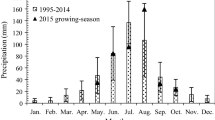Abstract
This study investigated the effect of a pine/oak forest canopy on rainfall chemistry in the Qinling Mountains. The area is an important water source for China’s North-to-South Water Transfer Project. Rainfall and throughfall samples were collected at the Huoditang Natural Forest in 1999, 2004, and 2009. Analyses of the samples indicated that the forest canopy had several important effects on rainfall chemistry. Rainfall pH generally increased as water passed through the canopy. On average, the rainfall pH increased by 0.54 pH units. The canopy’s effect declined after deciduous trees lost their leaves late in the sampling season. Rainfall NO3 − concentrations generally declined as water passed through the forest canopy, but PO4 3− concentrations generally increased. On average, rainfall NO3 − concentration declined by 0.135 mg/L as it passed though the forest canopy and PO4 3− increased by 0.85 mg/L. The forest canopy had a mitigating effect on the base cation content of throughfall. Specifically, K+, Na+, Ca2+ and Mg2+ were leached from the canopy when the concentration of these cations in rainfall was low. In contrast, K+, Na+, Ca2+ and Mg2+ were absorbed by the canopy when the concentration of these cations in rainfall was high. The pH of rainfall, as well as its K+, Ca2+ and Mg+ concentration, influenced the effect of the forest canopy on the base cation content of throughfall. The concentration of Cd, Pb, and Zn in rainfall generally decreased as water passed through the forest canopy, but the concentration of Fe in rainfall generally increased. The Cd concentration decreased by an average of 3.938 μg/L, the Pb concentration decreased by an average of 8.457 μg/L, and the Zn concentration decreased by an average of 0.986 mg/L. The Fe concentration increased by an average of 0.009 mg/L. The canopy’s ability to absorb Cd declined after several rainfall events in which rainfall Cd concentrations were relatively high.









Similar content being viewed by others
References
Calder IR (2007) Forests and water—ensuring forest benefits outweigh water costs. For Ecol Manag 251:110–120
Chen BF, Zeng QB, Huang Q, Zhou GY, Wu ZM, Li YD (1998) Ecohydrological effect of tropical mountain rain forest on Jianfengling, Hainan Island—canopy leaching and hydrochemical storage. Acta Ecol Sin 18(4):364–370
Chen BF, Chen Y, Yin GT, Ye SS, Ouyang W, Lin MX (2004) Study on the water quality of urban forest ecosystem in the Pearl River delta. For Res 17(4):453–460
Chiwa M, Crossley A, Sheppard LJ, Sakugawa H, Cape JN (2004) Throughfall chemistry and canopy interactions in a Sitka spruce plantation sprayed with six different simulated polluted mist treatments. Environ Pollut 127:57–64
Dang KL, Lei RD, Geng ZC, Zhang SX, Shen WJ (1996) Chemical properties of different types of soils at Huoditang forest region in the Qinling Mountains. J Northwest For Coll 11(s):26–30
Huang YZ, Zhu YG (2004) A review on cadmium contamination in forest ecosystem. Acta Ecol Sin 24(1):101–107
Komatsu H, Kume T, Otsuki K (2010) Water resource management in Japan: forest management or dam reservoirs? J Environ Manag 91:814–823
Li LH, Lin P, He JY, Jin CS (1994) Review on the study of forest precipitation chemistry. J Soil Water Conserv 8(1):84–96
Ma ZD, Zhang DC, Bi XY, Liu GQ, Ren LM, Quan HL (2005) Origin of cadmium high- value zones along the Yangtze River and Hanjiang River in Wuhan, Hubei. China Geol Bull China 24(8):740–743
Peng PH, Wang JX, Hu ZY, Gao HD (1996) The effects of the partioning of rainfall on the nutrients leaching processes in the mixed Alnus cremastogyne and Cupressus funebris forest. Chin J Ecol 15(5):12–15
Prakasa Rao PS, Momin GA, Safai PD, Pillai AG, Khemani LT (1995) Rain water and throughfall chemistry in the silent valley forest in south India. Atmospheric Environ 29(16):2025–2029
United States Environmental Protection Agency (Xu ZR translated) (1981) Quality criteria for water. China Architecture and Building Press, Beijing, pp 31–38, 95–109
Van Dijk AIJM, Keenan RJ (2007) Planted forests and water in perspective. For Ecol Manag 251:1–9
Wang B, Cui XH, Yang FW (2001) Reviewing global research development of forest and water through XXI IUFRO World Congress. World For Res 14(5):1–7
Wang Y, Liu XH, Jin LR, Yue TX, Wang DZ, Wang WX (2007) Spatial variations of heavy metals in precipitation at Mount Taishan region. Environ Sci 28(11):2562–2568
Zeng GM, Zhang G, Huang GH, Jiang YM, Liu HL (2005) Exchange of Ca2+, Mg2+ and K+ and uptake of H+, NH4 + for the subtropical forest canopies influenced by acid rain in Shaoshan forest located in Central South China. Plant Sci 168:259–266
Zhang SL (2009) Effects of forest ecosystem on heavy metals in water during the rainfall-runoff processes in the Huoditang forest area of the Qinling Mountain range. Sci Silvae Sin 45(11):55–62
Zhang SL, Li GL (2007) The effects of different components of the forest ecosystem on water quality in the Huoditang forest region, Qinling Mountain Range. Acta Ecol Sin 27(5):1838–1844
Zheng N, Wang QC, Zheng DM (2007) Transfer characteristics of mercury, lead, cadmium, zinc and cuprum from soil to vegetable around zinc smelting plant. Environ Sci 28(6):1349–1354
Zhou GY, Xu YG, Wu ZM, Luo TS, Li BQ, He ZC (2000) Influences of acid rain on crown leaching of chemical ions in different forest ecosystem in Guangzhou. For Res 13(6):598–607
Zhuang SH, Wang KM (2000) Study on the relationship between atmospheric heavy metal pollution (Pb, Cd, Cu, Zn) and its accumulations in leaves of urban trees. J Yantai Univ (Natural science and Engineering Edition) 13(1):31–37
Acknowledgments
This research was supported by the Forestry Special Research Program for Social and Public Interests (No. 201004036), which was sponsored by State Forestry Administration, P. R. China. We thank Dr. William J. Gale for revising the English in this manuscript.
Author information
Authors and Affiliations
Corresponding author
Rights and permissions
About this article
Cite this article
Zhang, S., Liang, C. Effect of a native forest canopy on rainfall chemistry in China’s Qinling Mountains. Environ Earth Sci 67, 1503–1513 (2012). https://doi.org/10.1007/s12665-012-1594-2
Received:
Accepted:
Published:
Issue Date:
DOI: https://doi.org/10.1007/s12665-012-1594-2




